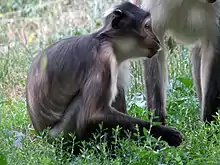Cercocebus atys
Singe vert Mangabey, Mangabey fuligineux
Cercocebus atys


VU : Vulnérable
Statut CITES
Cercocebus atys est une espèce de singes catarhiniens de la famille des cercopithecidés. Il est appelé Singe vert mangabey[1], Mangabey fuligineux, Cercocèbe enfumé ![]() [1] ou Mangabey enfumé
[1] ou Mangabey enfumé ![]() [2].
[2].
Une sous-espèce a été identifiée au Burkina Faso (Cercocebus atys lunulatus), déjà menacée de disparition[3],[4].

Juvénile
Taxonomie
L'ancienne sous-espèce Cercocebus atys lunulatus Temminick, 1853 a été reclassé en tant qu'espèce à part, Cercocebus lunulatus (Temminck, 1853).
Notes et références
- (en) Murray Wrobel, 2007. Elsevier's dictionary of mammals: in Latin, English, German, French and Italian. Elsevier, 2007. (ISBN 0-444-51877-0), 9780444518774. 857 pages. Rechercher dans le document numérisé
- Meyer C., ed. sc., 2009, Dictionnaire des Sciences Animales. consulter en ligne. Montpellier, France, Cirad.
- Galat, G., & Galat-Luong, A. (2006). Hope for the survival of the Critically Endangered white-naped mangabey Cercocebus atys lunulatus: a new primate species for Burkina Faso. Oryx, 40(3), 355-357|résumé
- McGraw, W. S. (1998). Three monkeys nearing extinction in the forest reserves of eastern Cote d'lvoire. Oryx, 32(3), 233-236.
Liens externes
- (en) Référence Mammal Species of the World (3e éd., 2005) : Cercocebus atys
- (fr+en) Référence ITIS : Cercocebus atys
- (en) Référence Catalogue of Life : Cercocebus atys (Audebert, 1797) (consulté le )
- (en) Référence CITES : espèce Cercocebus atys (Audebert, 1797) (+ répartition sur Species+) (consulté le )
- (en) Référence UICN : espèce Cercocebus atys (Audebert, 1797)
- Aidara, D., Tahiri-Zagret, C., & Robyn, C. (1981). Serum prolactin concentrations in mangabey (Cercocebus atys lunulatus) and patas (Erythrocebus patas) monkeys in response to stress, ketamine, TRH, sulpiride and levodopa. Journal of reproduction and fertility, 62(1), 165-172.
- Kone, I., & Akpatou, K. B. (2005). Identification des sites abritant encore les singes Cercopithecus diana roloway, Cercocebus atys lunulatus et Piliocolobus badius waldroni en Cote d’Ivoire. Report, Conservation des Espèces et Populations Animales (CEPA), Schlierbach, France.
- Koné, I., Bené, J. C., & Bitty, A. (2006). Prospections dans les forêts de l’extrême sud-est de la Côte-d’Ivoire en vue d’y confirmer la présence de Cercopithecus diana roloway, Cercocebus atys lunulatus et Piliocolobus badius waldronae: cas de la forêt non protégée de la lagune Ehy, de la Forêt Classée de N’gandan N’gandan et du Parc National des Îles Ehotilé. Rapport de mission pour CEPA, 21.
- Lowenstine, L. J., Pedersen, N. C., Higgins, J., Palus, K. C., Uyeda, A., Marx, P., ... & Gardner, M. B. (1986). Seroepidemiologic survey of captive old‐world primates for antibodies to human and simian retroviruses, and isolation of a lentivirus from sooty mangabeys (Cercocebus atys). International journal of cancer, 38(4), 563-574 |résumé.
- Santiago, M. L., Range, F., Keele, B. F., Li, Y., Bailes, E., Bibollet-Ruche, F., ... & Shaw, G. M. (2005). immunodeficiency virus infection in free-ranging sooty mangabeys (Cercocebus atys atys) from the Tai Forest, Cote d'Ivoire: implications for the origin of epidemic human immunodeficiency virus type 2. Journal of Virology, 79(19), 12515-12527.
- * Tomonaga, K., Katahira, J., Fukasawa, M., Hassan, M. A., Kawamura, M., Akari, H., ... & Isahakia, M. (1993). Isolation and characterization of simian immunodeficiency virus from African white-crowned mangabey monkeys (Cercocebus torquatus lunulatus). Archives of virology, 129(1-4), 77-92|résumé.
- Portail des primates
Cet article est issu de Wikipedia. Le texte est sous licence Creative Commons - Attribution - Partage dans les Mêmes. Des conditions supplémentaires peuvent s'appliquer aux fichiers multimédias.